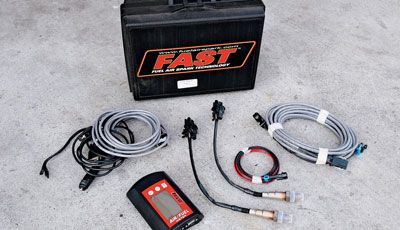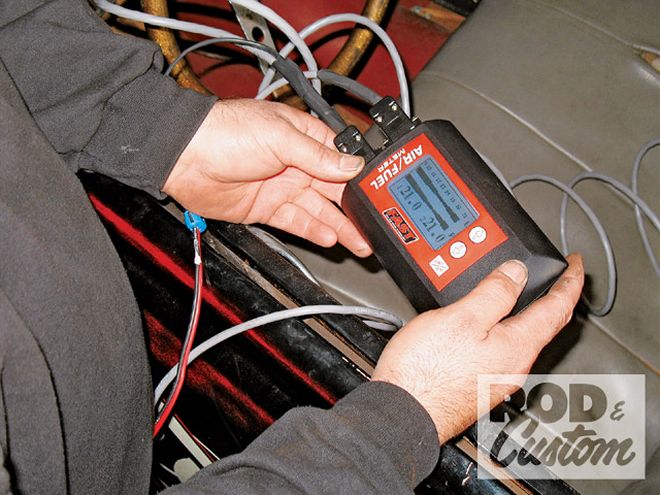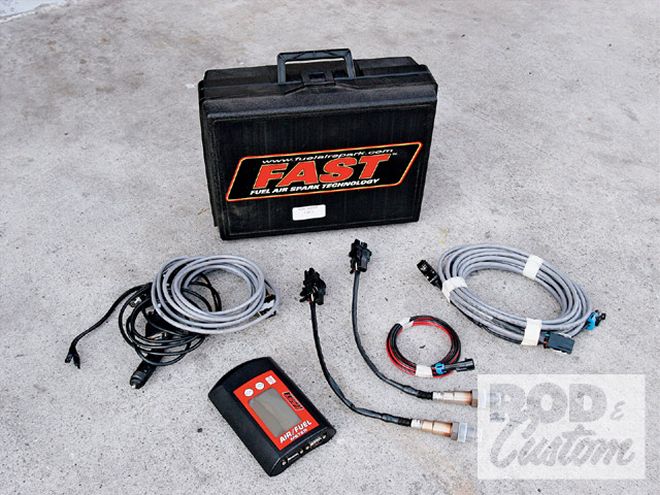

By now most people are aware that modern fuel -injected engines benefit greatly from the use of electronics, whether through the use of an on-board computer which constantly alters the tune depending on driving style, altitude or a number of other variables, or through the ability to plug in a laptop computer to make tuning changes. But in our little world the majority is still running carburetors and have in the past done our tuning with the combination of a screwdriver, seat-of-the-pants instinct and real-world testing on the street. Wouldn't it be nice to be able to know exactly what results you are getting from any tuning changes you make? It probably won't come as any great surprise when we tell you that you now can, thanks to the Fuel Air Spark Technology's (FAST) dual sensor air/fuel meter.
While there are a number of such meters available that allow you to see results from your tune-up while driving, the FAST meter has a couple of features that appeal to us. Its on-screen data logging means it doesn't require downloading the information to a laptop and its "Dual Sensor" capability means it can read data from both sides of a V-8, or any V-formation engine. This allows for more accurate carburetor tuning. An added bonus is that the kit is easy to use and simple to read--definitely a plus for the electronically challenged among us! The FAST meter can be used with computer-controlled engines and EFI, but it's carbureted motors we're interested in for the purposes of this article.
 The FAST dual sensor O2 air/fuel meter kit comes with a pair of O2 sensors, a lighted graphic display screen with built-in data logging facility, outputs for external data loggers, digital gauges, and a narrow-band simulator function that allows you to feed your engine's computer a factory signal while using the wide-band sensor for air/fuel measurement (not that we needed this on our carbureted engine). The meter takes its power from the vehicle's cigarette lighter to make it truly mobile.
The FAST dual sensor O2 air/fuel meter kit comes with a pair of O2 sensors, a lighted graphic display screen with built-in data logging facility, outputs for external data loggers, digital gauges, and a narrow-band simulator function that allows you to feed your engine's computer a factory signal while using the wide-band sensor for air/fuel measurement (not that we needed this on our carbureted engine). The meter takes its power from the vehicle's cigarette lighter to make it truly mobile.
So just how does the FAST meter work? It measures the air/fuel ratio, vital information not just for performance or economy tuning, but for anti-pollution reasons too. An optimum air/fuel ratio ensures a cleaner running engine as it offers the opportunity to achieve that perfect balance between being too rich or too lean. Modern factory vehicles with oxygen sensors automatically compensate for changes in the air/fuel ratio by analyzing exhaust gasses and adjusting accordingly, and the FAST meter works on this principle, letting the operator make changes to achieve the desired ratio, such as by changing jet sizes in the carburetor. This does mean installing a couple of threaded bungs in the headers or exhausts on cars not so equipped, in order to connect the O2 sensors. Hardly a major job, and they can be blanked off when not in use, but it does involve a little workshop time before the meter can be used.
Keen to put the FAST meter to the test, we hooked up with Westech Performance in Mira Loma, California to spend a morning at their facility doing just that. Our test mule for the session would be this author's '46 Ford roadster pickup. Hardly a performance combination, its 305ci Chevy small-block was rebuilt internally stock some 2,500 miles ago, but with headers, Pertronix ignition, and an Edelbrock Performer manifold. Running 87-octane gas, it's never going to win any drag races, but is perfect for what it was intended to be--a fun and useable pickup.
We were also keen to test Holley's new Street Avenger carburetor, as the truck had always seemed a little "flat" in performance, even given its mild motor. The aluminum Street Avenger is lighter than Holley's previous offerings, and lighter than the zinc Street Avengers too (it also stays brighter longer and is easier to polish!), has clear sight windows in the float chambers for easy float level adjustment, and comes already calibrated, as Holley's press blurb says, "Street ready out of the box."
So it was that we showed up at Westech one morning in March with the truck, a new Holley 670 Street Avenger and the FAST air/fuel meter kit. While the meter is designed to enable you to tune the engine at a cruise speed on the street, we strapped the pickup to Westech's dyno to simulate driving and make life easier on ourselves. Here's how the morning panned out.
Conclusion
The Holley Street Avenger carburetors are designed to be calibrated correctly straight out of the box if they're used for their intended application (and there's a chart on the Holley website to help determine this), though admittedly the 670cfm carburetor is slightly large for a 305ci engine and we'd probably have been better off starting with a 570, but then we probably wouldn't have been able to improve on the stock settings! Given the engine's stock state of tune and its stock cam, it wasn't going to respond to tuning much beyond what we did, but we did pick up 4 lb-ft of torque and almost three horsepower by installing smaller secondary jets. The motor also ran slightly leaner above 3,500 rpm, though admittedly its cruising speed in third gear is around 2,300 rpm, so it's a somewhat moot point on this vehicle.
Out on the road after the test however, the pickup was more responsive, with better acceleration, though I haven't driven it far enough yet to report any change in gas mileage. While the FAST meter is of more use on a performance engine, you can see how it is useful for tuning fuel delivery. 14 parts of air to fuel is where you'd expect to see a carbureted engine in the lower rpm range, so we were in the right area to start with, and managed to improve the ratio at higher revs while increasing both peak horsepower and torque. Sounds like a successful morning's work to us!